2016 MITSUBISHI OUTLANDER SPORT lock
[x] Cancel search: lockPage 24 of 398
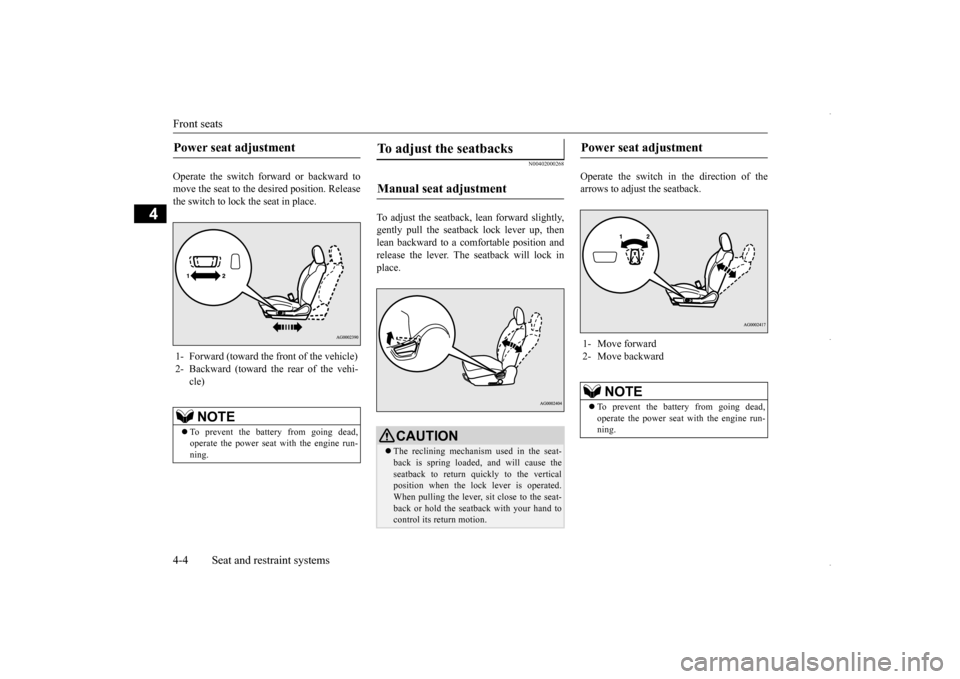
Front seats 4-4 Seat and restraint systems
4
Operate the switch forward or backward to move the seat to the desired position. Releasethe switch to lock the seat in place.
N00402000268
To adjust the seatback,
lean forward slightly,
gently pull the seatb
ack lock lever up, then
lean backward to a comfortable position and release the lever. The seatback will lock in place.
Operate the switch in the direction of the arrows to adjust the seatback.
Power seat adjustment 1- Forward (toward the front of the vehicle)2- Backward (toward the rear of the vehi-
cle)NOTE
To prevent the battery from going dead, operate the power seat with the engine run-ning.
To adjust the seatbacks Manual seat adjustment
CAUTION The reclining mechanism used in the seat- back is spring loaded, and will cause the seatback to return quickly to the verticalposition when the lock lever is operated. When pulling the lever, sit close to the seat- back or hold the seatback with your hand tocontrol its return motion.
Power seat adjustment 1- Move forward 2- Move backward
NOTE
To prevent the battery from going dead, operate the power seat with the engine run- ning.
BK0229600US.bo
ok 4 ページ 2015年10月1日 木曜日 午後2時29分
Page 28 of 398
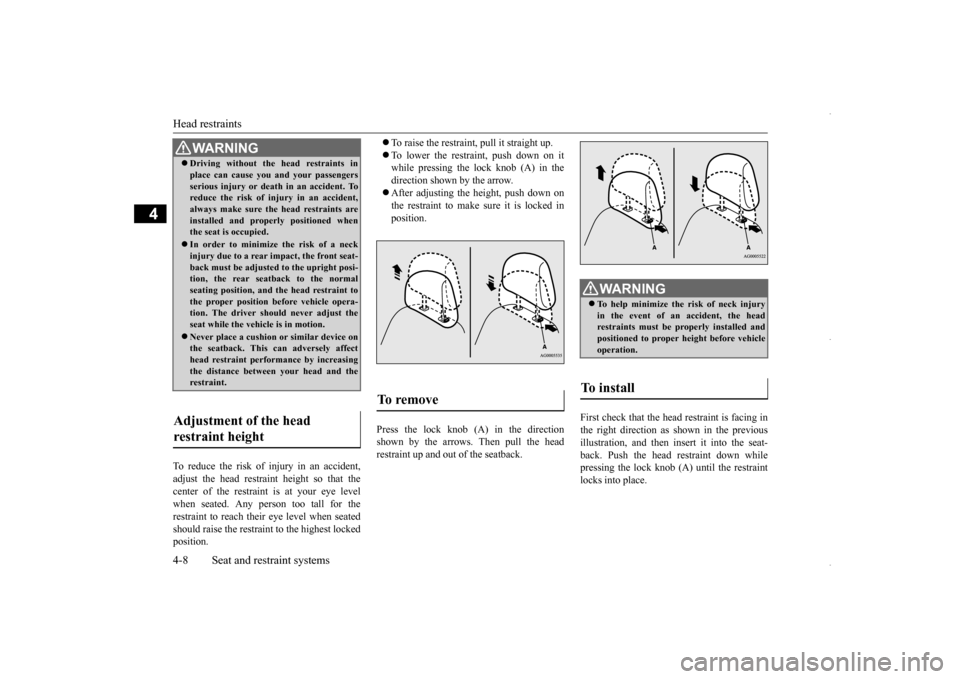
Head restraints 4-8 Seat and restraint systems
4
To reduce the risk of injury in an accident, adjust the head restraint height so that thecenter of the restraint is at your eye level when seated. Any person too tall for the restraint to reach their eye level when seatedshould raise the restraint to the highest locked position.
To raise the restraint, pull it straight up. To lower the restraint, push down on it while pressing the lock knob (A) in the direction shown by the arrow. After adjusting the height, push down on the restraint to make sure it is locked in position.
Press the lock knob (A) in the direction shown by the arrows. Then pull the head restraint up and out of the seatback.
First check that the head restraint is facing in the right direction as shown in the previous illustration, and then insert it into the seat-back. Push the head restraint down while pressing the lock knob (A) until the restraint locks into place.
WA R N I N G Driving without the head restraints in place can cause you and your passengers serious injury or death in an accident. To reduce the risk of injury in an accident, always make sure the head restraints areinstalled and properly positioned when the seat is occupied. In order to minimize the risk of a neck injury due to a rear impact, the front seat- back must be adjusted to the upright posi-tion, the rear seatback to the normal seating position, and the head restraint to the proper position before vehicle opera-tion. The driver should never adjust the seat while the vehicle is in motion. Never place a cushion or similar device on the seatback. This can adversely affect head restraint performance by increasingthe distance between your head and the restraint.
Adjustment of the head restraint height
To remove
WA R N I N G To help minimize the risk of neck injury in the event of an accident, the head restraints must be properly installed andpositioned to proper height before vehicle operation.
To install
BK0229600US.bo
ok 8 ページ 2015年10月1日 木曜日 午後2時29分
Page 29 of 398

Extending a luggage compartment Seat and restraint systems 4-9
4
N00405500105
CAUTION Check that the lock knob (A) is extended out as shown in the illustration. Then pull the head restraint up to make sure that it is locked in place and will not come out of the seatback.CAUTION The shape and size of the head restraint dif- fers according to the seat. Always use the correct head restraint provided for the seatand do not install the head restraint in the wrong direction.
Extending a luggage com- partment
WA R N I N G Never adjust the seats to extend a luggage compartment while the vehicle is inmotion or on a slope. The seats could move suddenly and cause serious injury or an accident. After returning a seatback to its normal position, make sure that the seatback isfirmly secured. If the seatback is not secured, it could move and cause a serious accident. Do not allow anyone to
ride in the luggage
compartment while the vehicle is inmotion. People who are not properly seated and restrained can be seriously injured or killed in an accident.
The luggage compartment in the rear of the vehicle should never be used as a play area by children. All children should be properly restrained in a restraint device that offers the maximum protection fortheir size and age. Refer to “Child restraint systems” on page 4-18. The front passenger seat is equipped with weight sensors. Depending on the weight detected, the front passenger airbag is dis-abled or enabled. When folding the rear seats forward for increased cargo capac- ity, the front passenger seat and seatbackmust be adjusted to assure they are not contacting the rear seat. In the event the front seat or seatback is allowed to contactthe folded rear seat, proper operation of the front passenger airbag system may be affected.CAUTION In the luggage compartment, do not load the luggage higher than the top of the seats and make sure that the luggage is firmly secured. Restricted rear vision or unsecured objects entering the passenger compartment from the luggage compartment during sudden brak-ing can cause serious injury or an accident. Seatbacks should always be folded and put back into normal position by an adult. Seat adjustments by a child could lead to an unex- pected accident.WA R N I N G
BK0229600US.bo
ok 9 ページ 2015年10月1日 木曜日 午後2時29分
Page 30 of 398
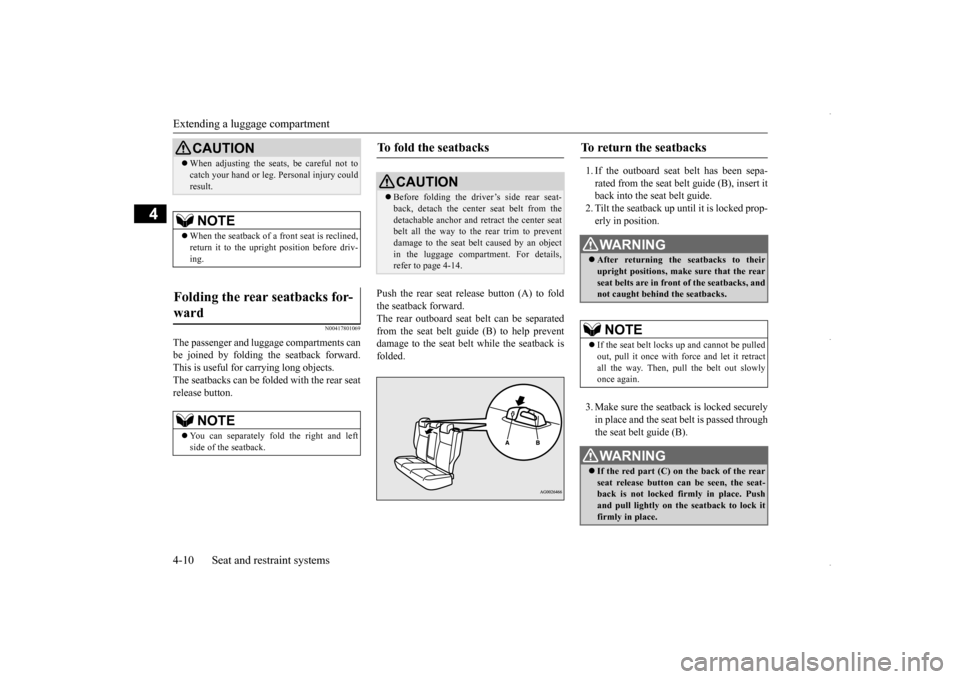
Extending a luggage compartment 4-10 Seat and restraint systems
4
N00417801069
The passenger and luggage compartments can be joined by folding the seatback forward. This is useful for carrying long objects.The seatbacks can be folded with the rear seat release button.
Push the rear seat release button (A) to fold the seatback forward.The rear outboard seat belt can be separated from the seat belt guide (B) to help prevent damage to the seat belt while the seatback isfolded.
1. If the outboard seat belt has been sepa- rated from the seat belt guide (B), insert it back into the seat belt guide.2. Tilt the seatback up until it is locked prop- erly in position. 3. Make sure the seatback is locked securely in place and the seat belt is passed through the seat belt guide (B).
When adjusting the seats, be careful not to catch your hand or leg. Personal injury could result.NOTE
When the seatback of a front seat is reclined, return it to the upright position before driv- ing.
Folding the rear seatbacks for- ward
NOTE
You can separately fold the right and left side of the seatback.CAUTION
To fold the seatbacks
CAUTION Before folding the driver’s side rear seat- back, detach the center seat belt from the detachable anchor and retract the center seat belt all the way to the rear trim to preventdamage to the seat belt caused by an object in the luggage compartment. For details, refer to page 4-14.
To return the seatbacks
WA R N I N G After returning the seatbacks to their upright positions, make sure that the rear seat belts are in front of the seatbacks, andnot caught behind the seatbacks.NOTE
If the seat belt locks up and cannot be pulled out, pull it once with force and let it retractall the way. Then, pull the belt out slowly once again.WA R N I N G If the red part (C) on the back of the rear seat release button can be seen, the seat- back is not locked firmly in place. Pushand pull lightly on the
seatback to lock it
firmly in place.
BK0229600US.bo
ok 10 ページ 2015年10月1日 木曜日 午後2時29分
Page 32 of 398
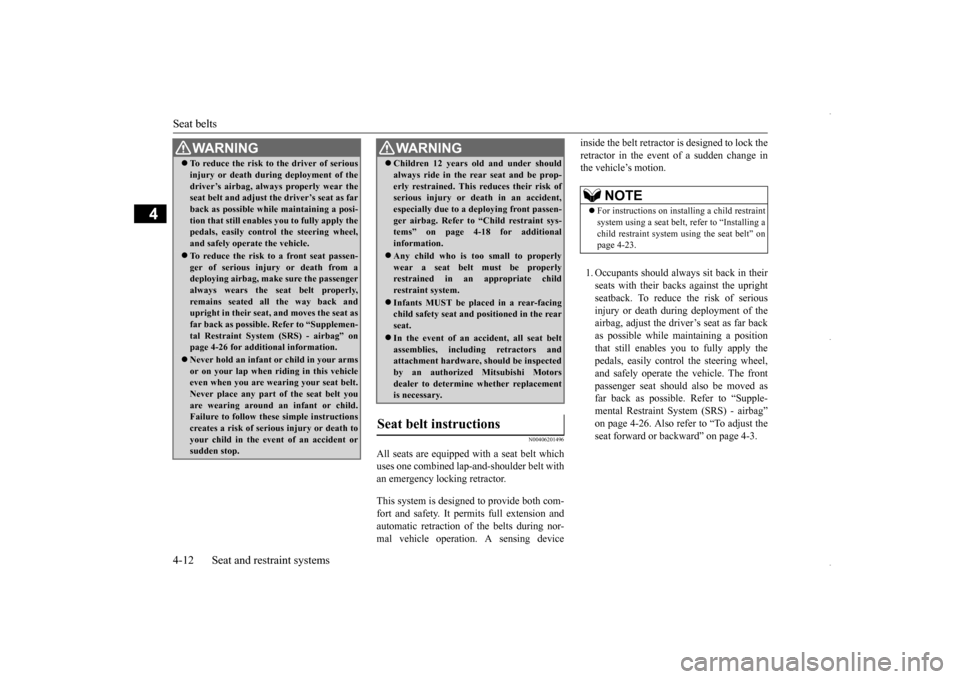
Seat belts 4-12 Seat and restraint systems
4
N00406201496
All seats are equipped with a seat belt which uses one combined lap-and-shoulder belt with an emergency locking retractor. This system is designed to provide both com- fort and safety. It permits full extension and automatic retraction of the belts during nor- mal vehicle operation. A sensing device
inside the belt retractor is designed to lock the retractor in the event of a sudden change in the vehicle’s motion. 1. Occupants should always sit back in their seats with their backs against the uprightseatback. To reduce the risk of serious injury or death during deployment of the airbag, adjust the driver’s seat as far backas possible while maintaining a position that still enables you to fully apply the pedals, easily control the steering wheel,and safely operate the vehicle. The front passenger seat should also be moved as far back as possible. Refer to “Supple-mental Restraint System (SRS) - airbag” on page 4-26. Also refer to “To adjust the seat forward or backward” on page 4-3.
To reduce the risk to the driver of serious injury or death during deployment of the driver’s airbag, always properly wear the seat belt and adjust the driver’s seat as far back as possible while maintaining a posi-tion that still enables you to fully apply the pedals, easily control the steering wheel, and safely operate the vehicle. To reduce the risk to a front seat passen- ger of serious injury or death from adeploying airbag, make sure the passenger always wears the seat belt properly, remains seated all the way back andupright in their seat, and moves the seat as far back as possible. Refer to “Supplemen- tal Restraint System (SRS) - airbag” onpage 4-26 for additional information. Never hold an infant or child in your arms or on your lap when riding in this vehicle even when you are wearing your seat belt. Never place any part of the seat belt youare wearing around an infant or child. Failure to follow these simple instructions creates a risk of serious injury or death toyour child in the event of an accident or sudden stop.WA R N I N G
Children 12 years old and under should always ride in the rear seat and be prop- erly restrained. This reduces their risk of serious injury or death in an accident, especially due to a deploying front passen-ger airbag. Refer to “Child restraint sys- tems” on page 4-18 for additional information. Any child who is too small to properly wear a seat belt must be properlyrestrained in an appropriate child restraint system. Infants MUST be placed in a rear-facing child safety seat and positioned in the rear seat. In the event of an accident, all seat belt assemblies, including retractors andattachment hardware, should be inspected by an authorized Mitsubishi Motors dealer to determine whether replacementis necessary.
Seat belt instructions
WA R N I N G
NOTE
For instructions on installing a child restraint system using a seat belt, refer to “Installing a child restraint system using the seat belt” on page 4-23.
BK0229600US.bo
ok 12 ページ 2015年10月1日 木曜日 午後2時29分
Page 33 of 398

Seat belts
Seat and restraint systems 4-13
4
2. Before using the rear center seat belt, make sure that the detachable anchor is securely latched and the seat belt is not twisted. For details, refer to page 4-14.
3. Grasp the latch plate and slide it up the webbing so that it easily pulls across your body. 4. Pull the seat belt out slowly while holding the latch plate. Push the latch plate into the buckle until you hear a “click”. Pullup on the belt to be sure the latch plate islocked securely in the buckle.
5. The lap part of the belt must always be worn low and snug across the hips. Pull up on the shoulder portion of the belt totake up any slack in the lap belt.
WA R N I N G To reduce the risk of serious injury or death in the event of an accident or sud- den stop, all seatbacks should be kept inthe upright position while the vehicle is in motion. Seat belt performance during an accidentcan be adversely affected if the seatbacks are reclined. The more a seatback is reclined, the more likely seat belt perfor-mance will be adversely affected. If the seat belt is not properly positioned against the body during an accident, there isincreased risk you will slide under the belt and receive serious injury or death.
NOTE
If the seat belt locks up and cannot be pulled out, pull it once with force and let it retract all the way. Then, pull the belt out slowly once again.
BK0229600US.bo
ok 13 ページ 2015年10月1日 木曜日 午後2時29分
Page 34 of 398

Seat belts 4-14 Seat and restraint systems
4
6. To release the belt, press the button on the buckle and allow the belt to retract.If the belt does not retract smoothly, pull it out and check for kinks or twists in the webbing. Then make sure it remainsuntwisted as it retracts.
N00409700017
The rear center seat belt can be detached tohelp avoid damage caused by an object in theluggage compartment while the driver’s side rear seat back is folded down.
1. Pull the seat belt out slowly and pass it through the seat belt guide (A). 2. After making sure that the seat belt is not twisted, insert the small latch plate (B) into the detachable anchor (C) aligning the marks (D) on the plate and buckleuntil a “click” is heard.
NOTE
With the exception of the seat belt for the driver, the seat belts in all other seating posi- tions are equipped with an Automatic Lock- ing Retractor (ALR) function. If you pull the seat belt fully out of the retractor, the retrac-tor will switch to its ALR child restraint installation function (see page 4-23). When the ALR function has been activated,the seat belt will only retract. If this happens, let the belt fully retract, then pull the seat belt back out, repeating steps 1 through 5.WA R N I N G Be sure the lap belt portion fits snugly and is worn as low as possible across the hips, not around the waist. Failure to follow thisinstruction will increase the risk of serious injury or death in the
event of an accident.
Be sure the seat belt webbing is not twisted when worn. Twisted webbing may adversely affect seat belt performance.
Detachable rear center seat belt
WA R N I N G Never detach the rear center seat belt except when the driver’s side rear seat back is folded down. Using the rear center seat belt with the detachable anchorunlatched increases the risk of serious injury or death in an accident. Make sure the detachable anchor is properly latchedbefore the center seat belt is used.
To attach
NOTE
If the seat belt locks up and cannot be pulled out, pull it once with force and let it retractall the way. Then, pull the belt out slowly once again.
BK0229600US.bo
ok 14 ページ 2015年10月1日 木曜日 午後2時29分
Page 36 of 398
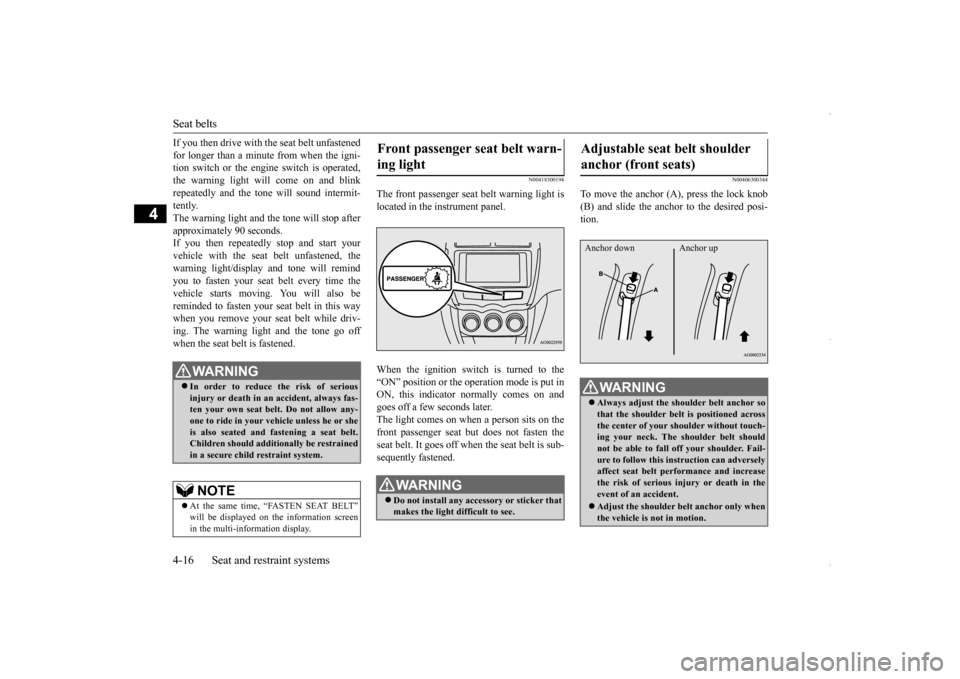
Seat belts 4-16 Seat and restraint systems
4
If you then drive with the seat belt unfastened for longer than a minute from when the igni- tion switch or the engine switch is operated, the warning light will come on and blinkrepeatedly and the tone will sound intermit- tently. The warning light and the tone will stop afterapproximately 90 seconds. If you then repeatedly stop and start your vehicle with the seat belt unfastened, thewarning light/display and tone will remindyou to fasten your seat belt every time the vehicle starts moving. You will also be reminded to fasten your seat belt in this waywhen you remove your seat belt while driv- ing. The warning light and the tone go off when the seat belt is fastened.
N00418300194
The front passenger seat belt warning light islocated in the instrument panel. When the ignition switch is turned to the “ON” position or the operation mode is put inON, this indicator normally comes on andgoes off a few seconds later. The light comes on when a person sits on the front passenger seat but does not fasten theseat belt. It goes off when the seat belt is sub- sequently fastened.
N00406300344
To move the anchor (A), press the lock knob (B) and slide the anchor to the desired posi- tion.
WA R N I N G In order to reduce the risk of serious injury or death in an accident, always fas- ten your own seat belt. Do not allow any-one to ride in your vehicle unless he or she is also seated and fastening a seat belt. Children should additionally be restrained in a secure child restraint system.NOTE
At the same time, “FASTEN SEAT BELT” in the multi-information display.
Front passenger seat belt warn- ing light
WA R N I N G Do not install any accessory or sticker that makes the light difficult to see.
Adjustable seat belt shoulder anchor (front seats)
WA R N I N G Always adjust the shoulder belt anchor so that the shoulder belt is positioned acrossthe center of your shoulder without touch- ing your neck. The shoulder belt should not be able to fall off your shoulder. Fail-ure to follow this instruction can adversely affect seat belt performance and increase the risk of serious injury or death in theevent of an accident. Adjust the shoulder belt anchor only when the vehicle is not in motion.
Anchor down Anchor up
BK0229600US.bo
ok 16 ページ 2015年10月1日 木曜日 午後2時29分